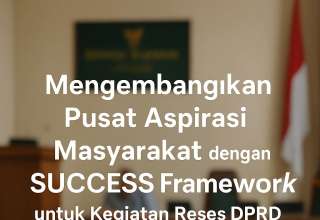*) Gambar sebagai ilustrasi
Applying the FINANCE Framework in Public Organizations
Developed by Mohamad Haitan Rachman
Introduction
Public organizations—whether they are government ministries, municipal administrations, or nonprofit agencies—play a critical role in shaping the well-being of society. Unlike private businesses that primarily pursue profit, public organizations are entrusted with resources that must be managed in the interest of citizens, stakeholders, and future generations. This unique responsibility makes financial management in the public sector not only a technical process but also a matter of transparency, accountability, and trust.
To address the complexity of financial governance in public institutions, Mohamad Haitan Rachman developed the FINANCE Framework. This systematic model provides a clear, seven-step structure: Forecast, Identify, Negotiate, Analyze, Navigate, Control, and Evaluate. Applied effectively, it enables public organizations to strengthen fiscal discipline, mitigate risks, and deliver measurable outcomes for society.
1. Forecast: Annual Budgets
Budget forecasting is the cornerstone of financial planning in public organizations. Unlike private companies, which may adjust spending based on revenue fluctuations, public organizations often operate with fixed or pre-approved budgets that must cover a wide range of societal needs.
Through the Forecast stage, public agencies:
- Project annual revenues and expenditures based on macroeconomic conditions, tax revenues, or expected grants.
- Align budget forecasts with strategic plans and government policies.
- Anticipate demographic trends, inflation, and external shocks such as natural disasters or economic downturns.
A robust forecast ensures that public resources are not only sufficient for ongoing programs but also adaptable to changing priorities. It provides clarity on how limited resources can serve maximum public benefit.
2. Identify: Funding Sources
The second stage emphasizes Identify. Public organizations must map all potential funding sources, which typically extend beyond core government revenues. These may include:
- Government appropriations: national or local budget allocations.
- Grants: from international agencies, donor institutions, or foundations.
- Sponsors and partnerships: contributions from the private sector under corporate social responsibility (CSR) programs.
Identifying multiple funding streams enhances financial resilience. It prevents over-reliance on a single source and allows organizations to diversify their capacity to fund programs. Moreover, transparency in identifying funding sources reassures stakeholders that money is legitimate, properly documented, and aligned with organizational missions.
3. Negotiate: Allocations for Priority Sectors
Once funding sources are clear, the next challenge is to Negotiate and Allocate resources to sectors of highest priority. In public organizations, this involves balancing competing needs: education, health care, infrastructure, environmental protection, and social welfare.
Effective negotiation requires:
- Stakeholder engagement: consulting communities, civil society, and sector experts.
- Evidence-based decision making: using data to determine where resources will achieve the greatest impact.
- Alignment with policy objectives: ensuring allocations are consistent with government strategies and long-term development goals.
Negotiation is not merely a budgeting exercise—it is a political and ethical process. Allocations demonstrate the organization’s values and its commitment to fairness, equity, and sustainability.
4. Analyze: Public Fund Usage
The Analyze stage is essential for monitoring how public funds are actually used. Unlike in the private sector, where owners or shareholders directly monitor profitability, public organizations are accountable to citizens, legislators, and auditors.
Analysis should include:
- Tracking expenditures: ensuring that funds are spent exactly as allocated.
- Comparing budget vs. actuals: identifying variances and their causes.
- Cost-benefit evaluations: determining whether programs deliver sufficient value for the money invested.
Analytical rigor helps prevent inefficiency, detect misuse early, and enhance public confidence. By embracing transparent analysis, public organizations strengthen their legitimacy and demonstrate stewardship of collective resources.
5. Navigate: Risks of Inefficiency and Corruption
Public organizations often face higher risks than private entities because they manage large budgets on behalf of citizens. Common risks include inefficiency, bureaucratic delays, and corruption.
The Navigate stage focuses on risk management through:
- Preventive measures: simplifying procedures, using digital systems, and minimizing opportunities for fraud.
- Capacity building: training staff to uphold ethical standards and professional integrity.
- Contingency planning: preparing for revenue shortfalls, political instability, or emergencies.
Corruption erodes trust, wastes resources, and undermines development. Navigating these risks requires both structural safeguards (such as anti-corruption commissions) and cultural change within organizations. The FINANCE Framework positions risk navigation not as an afterthought, but as a core responsibility of financial governance.
6. Control: Oversight Mechanisms
The Control stage ensures that financial systems remain disciplined and transparent. In public organizations, control extends beyond internal bookkeeping to include oversight by multiple layers of accountability.
Key mechanisms include:
- Internal audits: conducted regularly to ensure compliance with policies.
- External audits: performed by independent bodies to validate financial integrity.
- Parliamentary or council oversight: enabling elected representatives to scrutinize budgets and spending.
- Public participation: publishing budget information to empower citizens as watchdogs.
Robust oversight not only prevents mismanagement but also builds credibility. A culture of control reinforces the idea that public money is a public trust, not a personal entitlement.
7. Evaluate: Transparent Reporting
Finally, the Evaluate stage closes the cycle by assessing financial performance and reporting transparently to stakeholders. Evaluation should go beyond financial figures to examine outcomes and impacts.
Public organizations must ask:
- Were allocated funds spent as planned?
- Did spending achieve the intended policy goals?
- What lessons can be drawn for future budgeting cycles?
Transparent reporting is critical. Annual reports, open data portals, and citizen scorecards allow the public to see how their taxes and contributions are being used. This transparency fosters trust, enhances accountability, and strengthens democratic governance.
Integration with Other Frameworks
The FINANCE Framework developed by Mohamad Haitan Rachman is not a standalone tool. It integrates naturally with other governance and management frameworks:
- SCORE Framework for setting clear, outcome-based objectives.
- PERFORM Framework for maintaining excellence in execution.
- SYSTEM Framework for designing scalable financial systems.
Together, these models create a holistic ecosystem of public management where planning, performance, and accountability reinforce one another.
Conclusion
Public organizations bear a profound responsibility: to manage resources entrusted by citizens in ways that are transparent, efficient, and impactful. The FINANCE Framework offers a systematic approach to achieving this responsibility through seven interconnected stages:
- Forecast annual budgets.
- Identify diverse funding sources.
- Negotiate allocations to priority sectors.
- Analyze usage of public funds.
- Navigate risks of inefficiency and corruption.
- Control finances via oversight mechanisms.
- Evaluate with transparent reporting.
By applying this framework, public organizations can move beyond routine financial management to a culture of accountability, trust, and continuous improvement.
Developed by Mohamad Haitan Rachman, the FINANCE Framework empowers public institutions to deliver better governance and stronger outcomes for society. It ensures that every dollar, rupiah, or euro is not just spent but invested in the collective future.
If you have questions regarding training, mentoring, the analysis of the implementation of the FRAMEWORK, and the development of the systems we provide, as well as a desire for collaboration, please contact us through haitan.rachman@inosi.co.id.


